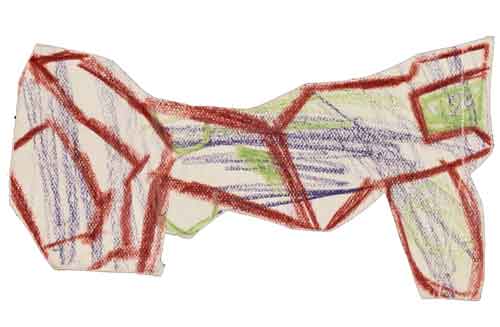Symbol formation象征形成

The term ‘symbol formation’ is used in psychoanalysis to denote a mode of indirect or figurative representation of a significant idea, conflict or wish.
术语“象征形成”在精神分析学中被用来表示对一个重要的想法、冲突或愿望的间接或形象化表达方式。
The ability to move on from relating concretely to archaic objects to relating symbolically to substitute objects (symbols) is both a developmental achievement and a move made because of the anxieties involved in relating to primal objects.
从远古客体的具体联系发展到象征性替代客体(象征)的能力,既是一种发展成就,也是由于与原始物体有关的焦虑而做出的一种转变。
Klein extended the ideas of both Freud and Jones on symbols, showing in particular the symbolic significance of play and how sublimation depends on the capacity to symbolise.
克莱因扩展了弗洛伊德和琼斯关于象征的思想,特别展示了游戏的象征意义,以及升华如何依赖于象征的能力。
Segal further developed Klein’s theory of symbols, distinguishing between the symbol proper formed in the depressive position and a more primitive version, the symbolic equation, belonging to paranoid-schizoid functioning. In the symbolic equation, the symbol is equated with the thing symbolised.
西格尔进一步发展了克莱因的象征理论,区分了抑郁状态下形成的符号和更原始的象征方程的版本,象征方程属于偏执-分裂的功能。在象征方程式中,象征等同于被象征的事物。
Reproduced from The New Dictionary of Kleinian Thought by Bott Spillius, E., Milton, J., Garvey, P., Couve, C. and Steiner, D. (Routledge, 2011)
Key papers by Freud and Klein
For full references for Melanie Klein’s works see Melanie Klein’s publications.
1895 Freud, S. and Breuer, J. Studies in Hysteria. Translated from the German and edited by J. Strachey and A. Strachey. New York: Basic Books (1957). Symptom formation through symbolisation.
1900 Freud, S. The Interpretation of Dreams. The Standard Edition of the Complete Psychological Works of Sigmund Freud, Vol. 4. Hogarth Press (1953). The importance of symbolism in dreams.
1923a Klein, M. ‘The role of the school in the libidinal development of the child’. Learning is inhibited when words and numbers are imbued with frightening, concrete symbolic significance.
1923b Klein, M. ‘Early analysis’. Contrary to Jones, Klein concludes that symbolism is the foundation of all sublimation.1929a Klein, M. ‘Personification in the play of children’. Symbolisation in play.
1929b Klein, M. ‘Infantile anxiety-situations in a work of art and in the creative impulse’. Symbolisation in play.
1930 Klein, M. The importance of symbol formation in the development of the ego’. Klein’s definitive statement on symbol formation.
Key papers by Segal
1952 Segal, H. ‘A psychoanalytic approach to aesthetics’, International Journal of Psychoanalysis. 33: 196-207; republished in M. Klein, P. Heimann and R. Money-Kyrle (eds.) New Directions in Psychoanalysis. Tavistock (1955); and in The Work of Hanna Segal. New York: Jason Aronson (1981). The link between the aesthetics and the depressive position.
1957 Segal, H. ‘Notes on symbol formation’, International Journal of Psychoanalysis. 38: 391-397; republished in The Work of Hanna Segal. New York: Jason Aronson (1981) and in E. Spillius (ed.) Melanie Klein Today, Vol. 1. Routledge (1988). Landmark paper on symbolisation.
1974 Segal, H. ‘Delusion and artistic creativity’, International Review of Psychoanalysis. 1: 135-141; republished in The Work of Hanna Segal. New York: Jason Aronson (1981) and in E. Spillius (ed.) Melanie Klein Today, Vol. 2. Routledge (1988). Golding’s novel The Spire is used to explore some aspects of creativity.
1979 Segal, H. Postscript to ‘Notes on symbol formation’. The Work of Hanna Segal. New York: Jason Aronson. Segal refines her 1957 symbol theory in terms of Bion’s container and contained.
Further exploration
Bion, W. (1962a) ‘A theory of thinking’. International Journal of Psychoanalysis. 43: 306-310.
Bion, W. (1962b) Learning from Experience. London: Heinemann.
Britton, R. (1998) ‘Daydream, phantasy and fiction’, in Belief and Imagination. London: Routledge, pp. 109-119.
Freud, S. (1895) ‘Project for a scientific psychology’. S. E. 1. London: Hogarth Press, pp. 283-397.
Freud, S. (1916) ‘Introductory lectures on psychoanalysis’. S. E. 15. London: Hogarth Press, p. 153.
Jones, E. (1916) ‘The theory of symbolism’. British Journal of Psychology. 9: 181-229.
Jones, E. (1948) ‘The theory of symbolism’, in Papers on Psychoanalysis. London: Maresfield Reprints, pp. 87-144.
Rickman, J. (1940) ‘On the nature of ugliness and the creative process’. International Journal of Psychoanalysis. 21: 294-313.
Sharpe, E. (1930) ‘Certain aspects of sublimation and delusion’. International Journal of Psychoanalysis. 11: 12-23.
Sharpe, E. (1935) ‘Similar and divergent unconscious determinants underlying the sublimations of pure art and pure science’. International Journal of Psychoanalysis. 16: 186-202.

